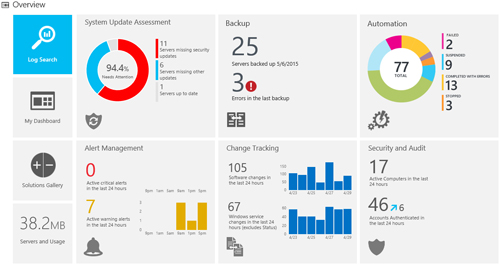News
Microsoft Targets Amazon with Operations Management Suite
- By David Ramel
- May 11, 2015
Microsoft unveiled its new Operations Management Suite (OMS) at the Ignite conference last week, giving organizations a tool to manage resources in clouds of any type, including Amazon Web Services (AWS).
Just as it has positioned its SQL Azure Data Warehouse as an alternative to AWS Redshift, Microsoft made no secret about who it was targeting with its new cloud management tool. "Gain control over any hybrid cloud," the OMS Web site states. "Manage Azure or AWS, Windows Server or Linux, VMware or OpenStack with our cost-effective, all-in-one cloud IT management solution."
In a blog post last week, Jeremy Winter, principal group PM manager at Microsoft, expounded on the theme.
"OMS extends your System Center investments and helps simplify management of your datacenter assets wherever they live," Winter said. "That means any instance in any cloud, including your datacenter, Azure, AWS, Windows Server, Linux, VMware, and OpenStack, at a lower cost than competitive solutions. OMS leverages a cloud-first approach to managing your enterprise for a fast and cost-effective way to meet new business challenges and accommodate new workloads, applications and cloud environments."
 [Click on image for larger view.] Microsoft Operations Management Suite (Source: Microsoft)
[Click on image for larger view.] Microsoft Operations Management Suite (Source: Microsoft)
AWS itself provides the AWS Management Console and a companion mobile app. A host of third-party options are also available, such as RightScale, SCALR, enStratus and mist.io. These and many others are discussed in the Quora topic, "What is the best Amazon AWS management tool?"
Despite those options, Winter said Microsoft developed the tool in response to feedback from customers, who are facing an increasingly difficult task of maintaining system stability in a time of agile development teams and datacenter assets scattered throughout different environments, including physical on-premises systems, virtualized setups or clouds.
Capabilities of the new tool are centered on providing log analytics, automation, availability and security.
Microsoft said the tool is built upon an analytics platform, and OMS lets users collect, store and analyze data collected in logs from any source to guide real-time operational intelligence decisions.
Interacting with real-time and historical machine data, improved troubleshooting functionality lets users quickly search through the data to investigate and fix issues.
The automation capability lets users offload manual and oft-repeated tasks to the machine. It also lets admins "create, monitor, manage and deploy resources in your hybrid cloud environment using runbooks, based on Windows PowerShell workflows," the company said.
For availability, OMS provides backup and integrated recovery for all servers and applications, wherever they are.
Security measures help identify malware status, collect info on security events and perform forensics, including audit and breach analysis. Patch management will be coming soon, Microsoft said.
Those initial capabilities will be improved upon, Winter said.
"Are we done?" he asked. "Not even close. We will continue to iterate quickly with you as we enhance both our cloud and on-premises capabilities. We have a pipeline of innovation already underway for areas like cloud-based patching, inventory, alerting, container management and more."
Pricing details separated into operational insights, backup, site recovery and automation can be found here.
About the Author
David Ramel is an editor and writer for Converge360.